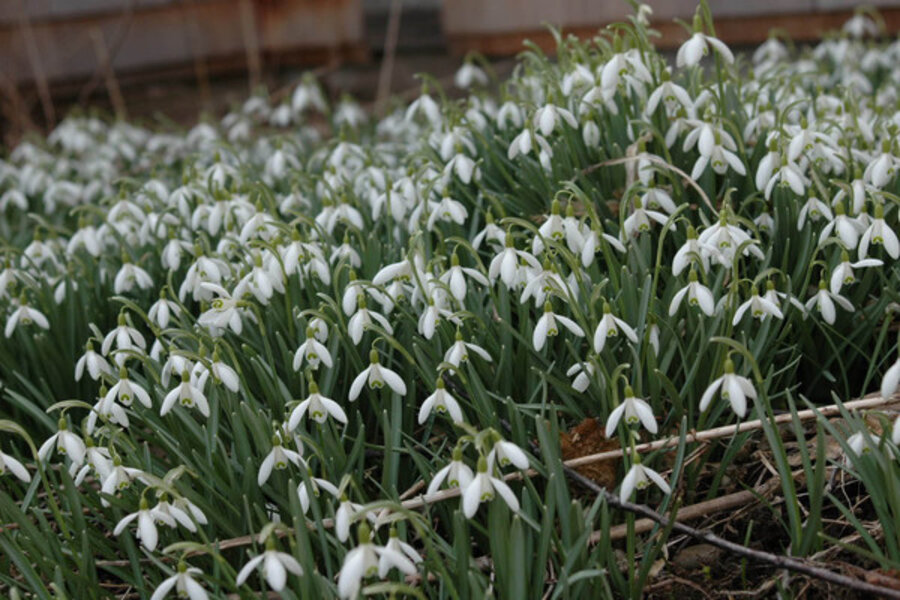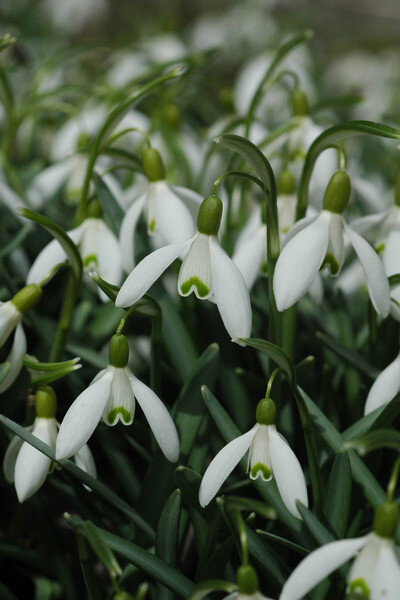Snowdrops usher in spring
Loading...
Snowdrops begin blooming about the time of the vernal equinox in Vermont, where I live, perfectly timed with spring. All Galanthus species — there are about 20 — are botanical immigrants, but few places are more congenial to growing them than is New England.
The galanthus in my garden are G. nivalis, common snowdrops. Don’t let “common” put you off: Snowdrops’ other country names — milk flower, fair-maid-of-February, Mary’s tapers, Candlemas bell — better point to the loveliness of these little blooms.
Each faintly scented flower hangs from a five-inch leafless scape like a delicate white bell marked with green.
There are scores of cultivars, including ‘Flora Pleno’, the best known double-flowered snowdrop, and ‘White Dreams’ with its white-striped leaves. There’s also the eye-popping and pricey Galanthus woronowii ‘Elizabeth Harrison’, which has yellow rather than green markings. (The seed company Thompson & Morgan bought a single bulb for about $1,100 last year.)
Flowers for weeks
‘Elizabeth Harrison’ isn’t likely to become part of my garden, but I do like giant snowdrops (G. elwesii), which are a bigger version of their common cousin. If you chose strategically, you can extend the galanthus season to several months by planting cultivars or species that bloom earlier or later.
But even if you plant only the common snowdrop, you’ll have flowers for several weeks as long as the temperatures stay cool.
Because galanthus bulbs continue to be dug by the tens of thousands in the wild, many species are officially “in decline"; Galanthus trojanus is “critically endangered,” the last stop before “extinct in the wild.” Make sure that any snowdrops you buy are labeled “nursery propagated.” Bulbs imported from Holland are nursery propagated, as are named cultivars.
Like other hardy bulbs, snowdrops are sold in the fall — 50 G. nivalis bulbs for $30 from Brent and Becky’s Bulbs. This is a bulb not to buy at the local box store, as freshness is important.
If you become snowdrop-smitten, you’re going to have to order from England and Scotland or join a rock garden or bulb society to find the rarer species and cultivars, as most US sources rarely offer more than a two or three choices. (But now, as soon as blooming stops and before the foliage dries, is the time to divide stands of snowdrops if you have a friend willing to share.)
Easy growing
Cultivation is easy. Snowdrops are happiest in USDA Zones 3 through 7 in dappled sun, perfect for setting under trees or shrubs, and look best when planted tightly in informal clumps, about a dozen bulbs per square foot.
Plant them at a depth about three times the height of the bulb in soil that has been enriched with compost, and unless there are weather extremes, leave them alone. (Before you begin naturalizing snowdrops in your lawn, remember that their foliage must be allowed to wither naturally -- no mowing until it disappears.)
Snowdrops share all the virtues of winter aconites, grape hyacinths, crocus, and other pocket-sized bulbs that usher in spring. They thrive in the coldest regions, aren’t damaged by spring winds and rain, and emerge unaffected by late snowfalls.
In addition to being relatively inexpensive, they naturalize, increasing every year without help from the gardener. Snowdrops are, as the housemaid explains in the book "The Secret Garden": “things as helps themselves.”
And nothing is nicer that that.
-----
Karan Davis Cutler is one of more than a dozen garden experts who blog regularly ab out gardening at the Monitor. To read more by Karan, click here. She's a former magazine editor and newspaper columnist and the author of scores of garden articles and more than a dozen books, including “Burpee -- The Complete Flower Gardener” and “Herb Gardening for Dummies.” Karan now struggles to garden in the unyieldingly dense clay of Addison County, Vt., on the shore of Lake Champlain, where she is working on a book about gardening to attract birds and other wildlife.








